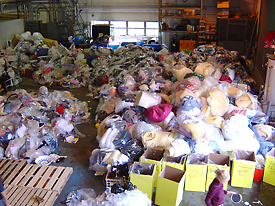More online
For more information about U-M’s Move-Out recycling program, go to tinyurl.com/y4wk5hg.
The winter term is waning, finals and papers are waxing. Move-Out is nigh. The annual student exodus has begun in these last days of April as students complete their exams.
Because Move-Out occurs gradually over several days, it is not the orchestrated street and curbside frenzy that occurs during Move-In. But each year it presents a shining moment in the university’s waste recycling program.
In 1989 University Housing began a funded recycling program for resident students, one of the first of its kind in the country. In collaboration with U-M Waste Management Services, the University Housing program has grown into a grand effort that promotes reuse as well as recycling.
Ellen Dankert is one of many U-M students who embraces the campus recycling efforts. “It’s important for the students to understand the vital role they play in the university’s commitment to sustainable practices,” says Dankert, who studies climate physics engineering. “Recycling is one of the easiest ways to do this, and it makes a big difference.”
At Move-Out, extra containers are added to the usual recycling locations throughout the residence halls and apartments. Last year, students leaving for the summer recycled 19.4 tons of paper, almost 6 tons of containers and 66.8 tons of refuse. Additionally, the donations program collected more than 10.2 tons of clothing, shoes, bedding, household items and nonperishable foods from residents and donated the goods to Purple Heart, Food Gatherers, St. Vincent DePaul and the Salvation Army.

Each year U-M students donate tons of items, shown at the North Campus Service Building #1, that are passed along to service organizations for redistribution. Photo by Courtesy Tracy Artley.
“The Move-Out Donation Program is one of the efforts we are most proud of,” says Tracy Artley, recycling coordinator for Waste Management Services. “In addition to being a wonderful collaboration with Housing, it’s an opportunity for the university to give back to the community while reducing our ecological footprint. This time of year, we’re out to tell the students ‘Don’t dump it, donate it.’”
Eileen Spring, director of Food Gatherers, acknowledges that the donation program is a plus for their organization, which is dedicated to fighting local hunger. “The food items that come to us from the student Move-Out program are redistributed to our many nonprofit partners, including shelters, community centers, churches and after-school programs. Instead of going to waste, it goes to people in need.”
Donations are a great way to let others reuse items that students don’t want, can’t believe they own or simply don’t have room for in the car, but parents may want to declare what stuff of theirs should come back home, organizers say.
Waste Management Services also will place collection boxes in the following campus buildings for donations from staff, faculty, and off-campus students:
• Pierpont Commons/Duderstadt Connector
• Angell Hall
• Dana Building
• Chemistry Building
The City of Ann Arbor offers a free drop-off location for bagged refuse, discarded furniture, as well as donations of clothing, furniture, appliances, nonperishable food items and more. This year, the drop-off location at East University and Oakland streets will be open from 11 a.m.-5 p.m. Tuesday through May 8. For more information go to tinyurl.com/y3gca5g.
“We have to be conscious of the fact that we all contribute to the waste stream,” says Anna James, who studies civil and environmental engineering. “Once we’re conscious of that fact, we can work to minimize our contribution through recycling, reusing and even reducing our consumption of resources.”

